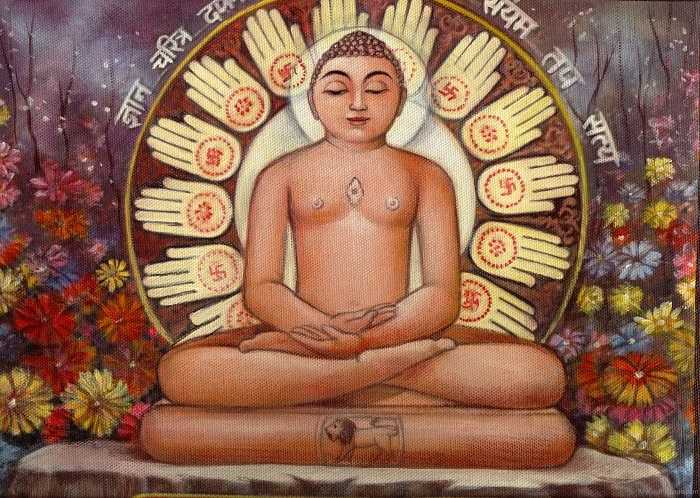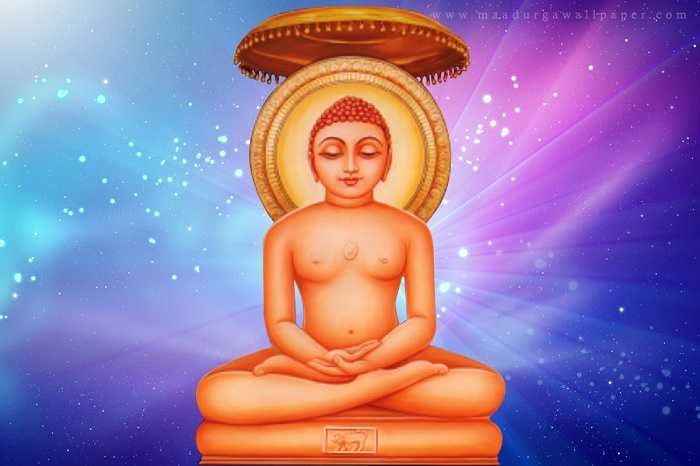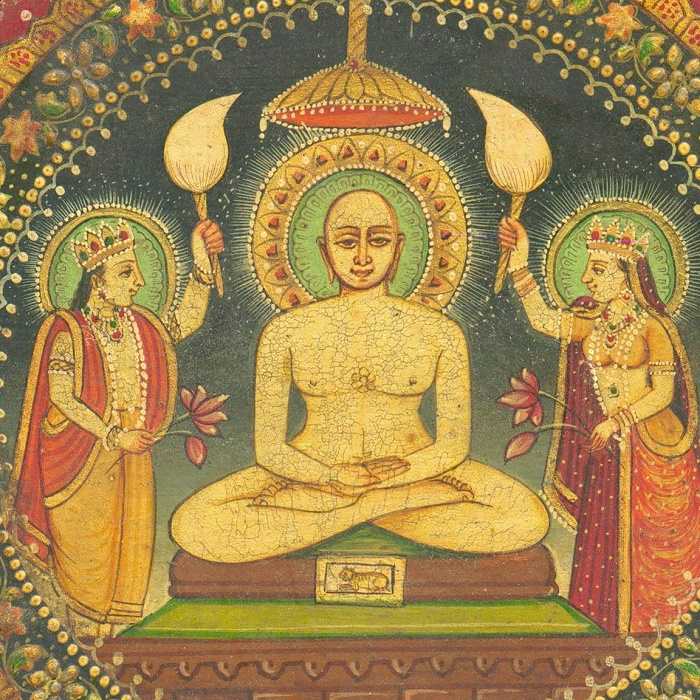Name: Vardhamana
Birth: 599 B.C.
Birth Place: Kshatriyakund, Vaishali (in modern day Bihar)
Parents: Kingh Siddhartha and Queen Trishala
Spouse: Yashoda
Children: Priyadarshana (daughter)
Titles: Mahavira, Trirthankar, Jina
Age of Attaining Kevala Jnana: 42 years
Ideology: Jainism
Death: 527 B.C.
Age of attaining Moksha: 72 years

Lord Mahavira was the twenty-fourth and last Jain Tirthankara according to the Jain philosophy. A Tirthankara is an enlightened soul who is born as a human being and attains perfection through intense meditation. For a Jain, Lord Mahavira is no less than God and his philosophy is like the Bible. Born as Vardhamana Mahavir, he later came to be known as Bhagvan Mahaveer. At the age of 30, Vardhamana left his home in pursuit of spiritual awakening, and for the next twelve-and-a-half years, he practiced severe meditation and penance, after which he became omniscient. After achieving Kevala Jnana, he travelled throughout the Indian subcontinent to teach Jain philosophy for the next 30 years.
Early Life
Lord Mahaveera was born Prince Vardhamana to King Siddhartha and Queen Trishala of the Ikshvaku Dynasty. He was born in 599 B.C. on the thirteenth day of the rising moon during the month of Chaitra in the Vira Nirvana Samvat calendar. According to Gregorian calendar, Vardhamana was born during the month of March-April, which is when Mahaveer Jayanti is celebrated today. Most historians agree that he was born in Kshatriyakund in the Kingdom of Vaishali which is in modern day Bihar.
When Queen Trishala was pregnant with Vardhamana she had the 14 dreams depicted in Jain scriptures indicating that her unborn child was destined to greatness. His parents were followers of the Jain ascetic Parashwanatha. As a child Vardhamana was quiet but brave. He displayed acts of great courage several times during difficult situations. Being a prince he was brought up amidst much luxury yet nothing affected him. He led a very simple life. Following his parent’s instructions, he married Princess Yashoda, at a very young age and the couple had a daughter, Priyadarshana. The Digambara sect of Jainism believes that Vardhamana refused to get married when his parents insisted.

Renunciation
When Vardhamana was 28, his parents passed away and his elder brother Nandivardhana succeeded their father. Vardhamana craved freedom from the worldly attachments and sought his brother’s permission to renounce his royal life. His brother tried to dissuade him from his resolve but Vardhamana was adamant, practicing fast and meditation at home. At 30 years of age, he finally abandoned his home and embraced the ascetic life of a monk on the tenth day of Margsirsa. He gave away his possessions, put on a single piece of cloth and uttered “Namo Siddhanam” (I bow down to the liberated souls) and left all his worldly attachments behind.
Penance and Omniscience
Mahavira spent the next twelve and a half years pursuing a life of hard penance to drive away his basic attachments. He practiced complete silence and rigorous meditation to conquer his basic desires. He assumed a calm and peaceful demeanor and sought to overcome emotions like anger. He discarded his clothes and put himself through immense hardships. He practiced a philosophy of non-violence against all living being. He moved from place to place, often observing fasts and sleeping for only 3 hours each day. During his twelve years of penance he travelled through Bihar, western and north Bengal, parts of Orissa and Uttar Pradesh.
After experiencing 12 years of hard penance, a tired Mahaveera is said to have fallen asleep for a few moments when he experienced a series of 10 strange dreams. These dreams and their significance have been explained in Jain Scriptures as follows:
1. Defeating a Lion – signifies destruction of ‘moha’ or worldly attachment
2. A bird with white feathers following him – signifies attainment of purity of mind
3. A bird with multicolored feathers – signifies attainment and propagationof multifaceted knowledge
4. Two gem strings appear in front – symbolizes preaching a dual religion, an amalgamation of principles from a monk’s life and duties of a common man.
5. A herd of white cows – symbolizes a group of devoted followers who will serve
6. A pond with open lotuses – symbolizes presence of celestial spirits who will propagate the cause
7. Crossed a waxy ocean swimming – symbolizes freedom from the cycles of death and rebirths
8. Sun rays spreading in all directions – symbolizes attainment of Kevala Jnana (Omniscience)
9. Encircling the mountain with your bluish intestines – symbolizes the universe will be privy to the knowledge
10. Sitting on a throne placed on summit of the Mount Meru – symbolizes people revering the knowledge being taught and placing Mahaveer in a place of respect.
On the tenth day of the rising moon during the month of Vaisakh, 557 B.C., Mahavira sat under a Sal tree on the banks of river Rijuvaluka (modern day river Barakar), and attained the Kevala Jnana or omniscience. He finally experienced perfect perception, perfect knowledge, perfect conduct, unlimited energy, and unobstructed bliss. He became a Jina, the one who is victorious over attachment.

Spiritual Journey
According to Jain scriptures, Mahavira held Samavasarana (a preaching pavillion) to spread his knowledge among the common people. His first Samavasarana was not successful and he held a second one at the city of Pava in the garden of Mahasena. Here his words of wisdom resonated with the masses, and eleven Brahmins chose to embrace his preaching and convert to Jainism. These eleven Brahmins namely, Achalbhadra, Agnibhuti, Akampita, Indrabhuti, Mandikata, Mauryaputra, Metarya, Prabhasa, Sudharma, Vayubhuti, and Vyakta, became his chief disciples or Gandhars. Lord Mahavira imparted the Tripadi Knowledge (Three Pronouncements) to his chief disciples which where Upaneiva (Emergence), Vigameiva (Distruction) and Dhuveiva (Permanence).
Organization
The eleven chief disciples of Mahavira brought their own followers into the fold of his teachings. These 4400 followers became first of the Jain Shramanas. Eventually common people also joined his order and Mahaveer ultimately lead a community of 14,000 monks (muni), 36,000 nuns (aryika), 159,000 laymen (shravakas) and 318,000 laywomen (shravika). These four groups constitute the fourfold order or four tirthas of Jainism. Some of his royal followers included King Chetaka of Vaishali, King Shrenik Bimbisar and Ajatshatru of Rajagriha, King Udayana, King Chandrapadyot, Nine Licchavis Kings of Koshal and Nine Kings of Kashi.
Nirvana
Mahavir devoted his life towards spreading his Keval Jnana among people and gave discourses in local languages as opposed to in elite Sanskrit. His final discourse was at Pavapuri which lasted for 48 hours. He attained moksha shortly after his final discourse, finally liberated from the cycle of life, death and rebirth during 527 B.C. at the age of 72.

Image Credit: http://www.thefamouspeople.com/profiles/images/mahavira-4.jpg
Teachings
Lord Mahavira was the last and 24thTirthankara of Jainism and is responsible for reordering the religion and introducing the Jain Sangha. Lord Mahavira considered men and women to be spiritual equals and that they both may renounce the world in search of Moksha. Lord Mahavira encouraged participation of people from all social standings, rich and poor, men and women, touchable and untouchable.
The ultimate goal behind practicing the teachings of Lord Mahavira is to attain freedom from the cycle of rebirth as human life is representative of pain, misery and vices. According to him, every living being suffers under the bondage of Karma, which is the accumulation of that being’s deeds. Souls seek pleasures in materialistic possessions that result into introductions of vices like self-centeredness, greed, anger and violence. These result into accumulation of bad karma which does not allow souls to be liberated from the cycle. He preached that the real path leading to attainment of liberation from the cycle of Karma is through Samyak Darshana (right faith), Samyak Jnana (right knowledge) and Samyak Charitra (right character). These three basic principles were further elaborated by the Gandhar Gautama Swami into the twelve parts sacred scriptures known as the 12 Agamas. Sermons of Lord Mahaveera were compiled in the Agam Sutras by his disciples and were passed on to the common people through oral recitations.
These scriptures prescribe 5 basic vows that should be observed by monks and common disciples alike. These five basic vows are
1. Nonviolence (Ahimsa) - not to cause harm to any living beings
2. Truthfulness (Satya) - to speak the harmless truth only
3. Non-stealing (Asteya) - not to take anything not properly given
4. Chastity (Brahmacharya) - not to indulge in sensual pleasure
5. Non-possession/Non-attachment (Aparigraha) - complete detachment from people, places, and material things.
Teachings and philosophy of Lord Mahavira laid down the foundation of a novel sect of Jainism known as the Digambaras, apart from the pre-existing Shwetambaras. The Digambaras believe that attaining moksha through a life of strict penance and by practicing nudity to symbolize freedom from worldly attachments.
The spiritual philosophy of Lord Mahavira encompasses eight cardinal principles – of them three metaphysical and five are ethical. Jains believe in the eternal existence of the Universe - neither it was created and nor can it be destroyed. Mahavira thought that the Universe is made up of six eternal substances – Souls, Space, Time, Material Atoms, Medium of Motion and Medium of Rest. These independent components undergo changes to create the multifaceted reality that mortals exist in. Lord Mahavira introduced the philosophy of Anekantvada (principle of non-absolutism) that refers to pluralism of existence. It teaches that truth and reality may differ when perceived from different points of views, and that no single view represents the absolute truth. This multifaceted reality is better explained with Syadvada or the Principle of Seven Fold Predictions. The principle of Partial Stand Points or Nayvada is also an offshoot of Anekantvada, reinforcing the Jain belief of existence of infinite points of view, each expressing a partial truth.



